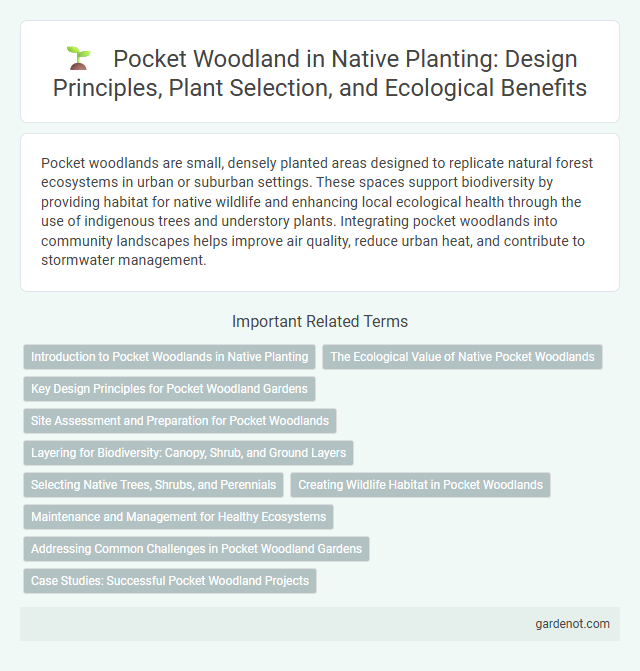Pocket woodlands are small, densely planted areas designed to replicate natural forest ecosystems in urban or suburban settings. These spaces support biodiversity by providing habitat for native wildlife and enhancing local ecological health through the use of indigenous trees and understory plants. Integrating pocket woodlands into community landscapes helps improve air quality, reduce urban heat, and contribute to stormwater management.
Introduction to Pocket Woodlands in Native Planting
Pocket woodlands are small, densely planted areas featuring native tree species that support local biodiversity and create resilient ecosystems within urban or suburban settings. These compact woodlands enhance habitat connectivity for wildlife, improve air quality, and promote soil health by mimicking natural forest processes. Integrating native plants in pocket woodlands ensures adaptability to local climate conditions while fostering pollinator populations and reducing maintenance requirements.
The Ecological Value of Native Pocket Woodlands
Native pocket woodlands enhance urban biodiversity by providing essential habitats for pollinators, birds, and small mammals, contributing to ecosystem resilience. These small-scale forests improve air quality and support soil health through natural nutrient cycling and carbon sequestration. Their strategic planting in urban areas mitigates heat islands while fostering native plant species diversity and ecological connectivity.
Key Design Principles for Pocket Woodland Gardens
Pocket woodland gardens emphasize native plant species to promote biodiversity and ecological resilience. Key design principles include planting a mix of canopy, shrub, and ground layers to mimic natural forest structures, ensuring seasonal interest and habitat diversity. Incorporating locally sourced soil and organic mulch supports soil health and encourages native fauna, enhancing the ecosystem's sustainability.
Site Assessment and Preparation for Pocket Woodlands
Site assessment for pocket woodlands involves evaluating soil quality, sunlight exposure, and existing vegetation to ensure optimal tree growth and biodiversity. Preparing the site includes removing invasive species, amending soil with organic matter, and creating protective barriers against pests and erosion. Proper site evaluation and preparation maximize the health and sustainability of native pocket woodlands.
Layering for Biodiversity: Canopy, Shrub, and Ground Layers
Pocket woodlands enhance biodiversity by incorporating distinct vegetation layers such as a tall canopy of native trees, a dense shrub layer, and a rich ground cover of herbaceous plants. Each layer provides unique habitats and food sources, supporting diverse wildlife including birds, insects, and small mammals. Strategic layering in pocket woodlands maximizes ecological benefits and creates resilient, self-sustaining ecosystems in urban and suburban environments.
Selecting Native Trees, Shrubs, and Perennials
Selecting native trees, shrubs, and perennials for a pocket woodland ensures ecosystem compatibility and supports local wildlife. Prioritize species like oak, dogwood, and spicebush that thrive in regional soil and climate conditions while providing habitat and food sources for birds, insects, and mammals. Incorporating diverse native plants also improves soil health, enhances biodiversity, and reduces maintenance needs by leveraging natural growth patterns.
Creating Wildlife Habitat in Pocket Woodlands
Pocket woodlands planted with native species foster diverse wildlife habitats by providing essential food, shelter, and nesting sites for birds, insects, and small mammals. These compact green spaces enhance local biodiversity by supporting pollinators like bees and butterflies, while also serving as stopover points for migratory species. Incorporating native trees, shrubs, and groundcover in pocket woodlands strengthens ecosystem resilience and promotes natural ecological balance within urban or suburban environments.
Maintenance and Management for Healthy Ecosystems
Regular pruning and removal of invasive species are essential to maintain a pocket woodland's health, ensuring native plants thrive without competition. Soil health monitoring and mulching support nutrient cycling and moisture retention, promoting robust tree and understory growth. Periodic assessment of biodiversity indicators helps guide adaptive management practices, fostering a resilient ecosystem.
Addressing Common Challenges in Pocket Woodland Gardens
Pocket woodland gardens often face challenges such as limited space, poor soil quality, and inadequate sunlight. Selecting native shade-tolerant plant species like ferns, wild ginger, and native dogwood enhances biodiversity and improves soil health through natural organic matter decomposition. Incorporating layered planting strategies with groundcovers, shrubs, and small trees maximizes space efficiency and creates resilient microhabitats that support local wildlife.
Case Studies: Successful Pocket Woodland Projects
Pocket woodland projects demonstrate effective urban reforestation by transforming small, underutilized spaces into thriving native habitats. Case studies from cities like London and Portland highlight increased biodiversity, improved air quality, and enhanced community engagement through strategic planting of native tree species such as oak, birch, and hawthorn. These projects serve as scalable models for fostering ecological resilience and supporting local wildlife in densely populated areas.
Pocket woodland Infographic

 gardenot.com
gardenot.com